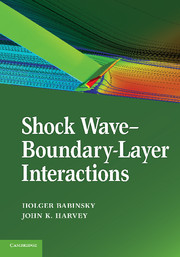Book contents
- Frontmatter
- Brief Contents
- Contents
- Contributors
- 1 Introduction
- 2 Physical Introduction
- 3 Transonic Shock Wave???Boundary-Layer Interactions
- 4 Ideal-Gas Shock Wave???Turbulent Boundary-Layer Interactions (STBLIs) in Supersonic Flows and Their Modeling: Two-Dimensional Interactions
- 5 Ideal-Gas Shock Wave???Turbulent Boundary-Layer Interactions in Supersonic Flows and Their Modeling: Three-Dimensional Interactions
- 6 Experimental Studies of Shock Wave???Boundary-Layer Interactions in Hypersonic Flows
- 7 Numerical Simulation of Hypersonic Shock Wave???Boundary-Layer Interactions
- 8 Shock Wave???Boundary-Layer Interactions Occurring in Hypersonic Flows in the Upper Atmosphere
- 9 Shock-Wave Unsteadiness in Turbulent Shock Boundary-Layer Interactions
- 10 Analytical Treatment of Shock Wave???Boundary-Layer Interactions
- Index
- References
10 - Analytical Treatment of Shock Wave???Boundary-Layer Interactions
Published online by Cambridge University Press: 05 June 2012
- Frontmatter
- Brief Contents
- Contents
- Contributors
- 1 Introduction
- 2 Physical Introduction
- 3 Transonic Shock Wave???Boundary-Layer Interactions
- 4 Ideal-Gas Shock Wave???Turbulent Boundary-Layer Interactions (STBLIs) in Supersonic Flows and Their Modeling: Two-Dimensional Interactions
- 5 Ideal-Gas Shock Wave???Turbulent Boundary-Layer Interactions in Supersonic Flows and Their Modeling: Three-Dimensional Interactions
- 6 Experimental Studies of Shock Wave???Boundary-Layer Interactions in Hypersonic Flows
- 7 Numerical Simulation of Hypersonic Shock Wave???Boundary-Layer Interactions
- 8 Shock Wave???Boundary-Layer Interactions Occurring in Hypersonic Flows in the Upper Atmosphere
- 9 Shock-Wave Unsteadiness in Turbulent Shock Boundary-Layer Interactions
- 10 Analytical Treatment of Shock Wave???Boundary-Layer Interactions
- Index
- References
Summary
Introduction
Motivation for Analytical Work in the Computer Age
Notwithstanding the success of powerful CFD codes in predicting complex aerodynamic flowfields, analytical methods continue to be a valuable tool in the study of viscous-inviscid interaction problems for the following reasons:
Such methods appreciably enhance physical insight by illuminating the underlying basic mechanisms and fine-scale features of the problem, including the attendant similitude properties [1]. An example in the case of shock wave–boundary-layer interaction (SBLI) is the fundamental explanation of the phenomena of upstream influence and free interaction provided by the pioneering triple-deck–theory studies of Lighthill [2], Stewartson and Williams [3], and Neiland [4].
Analysis provides an enhanced conceptual framework to guide both the design of related experimental studies and the correlation and interpretation of the resulting data. This was exemplified in a recent study of wall-roughness effects on shock-wave–turbulent boundary-layer interaction wherein a two-layered analytical theory revealed key features and appropriate scaling properties of the problem that were then used to design and evaluate a companion experimental program [5].
Analytical solutions can enhance substantially the efficiency and cost-reduction of large-scale numerical codes [6] by both providing accurate representation of otherwise difficult far-field boundary conditions and serving as an imbedded local element within a global computation to capture key smaller-scale physics. An example of the latter is the application of a small-perturbation theory of transonic normal shock–turbulent boundary-layer interaction in a global inviscid-boundary layer [7]; the resulting hybrid code provided more than 100-fold savings in design-related parametric-study costs.
A final noteworthy benefit is the occasional revelation of the deeper basic explanation for well-known empiricisms, such as the local pressure-distribution inflection-point criteria for incipient separation that are widely used by experimentalists.
Information
- Type
- Chapter
- Information
- Shock Wave-Boundary-Layer Interactions , pp. 395 - 458Publisher: Cambridge University PressPrint publication year: 2011
References
Accessibility standard: Unknown
Why this information is here
This section outlines the accessibility features of this content - including support for screen readers, full keyboard navigation and high-contrast display options. This may not be relevant for you.Accessibility Information
- 2
- Cited by
